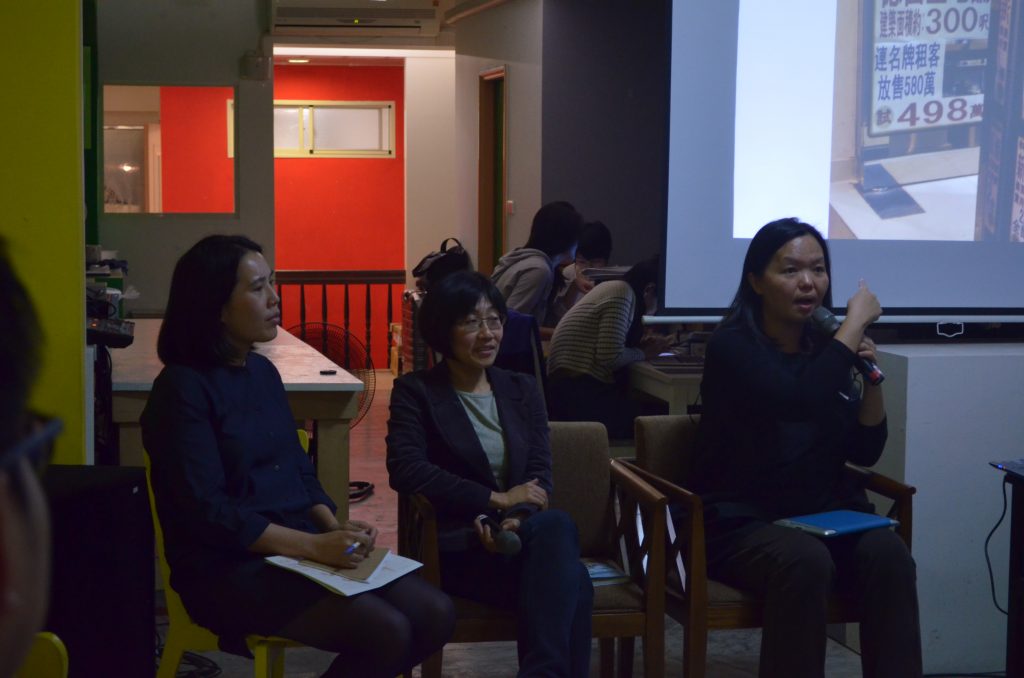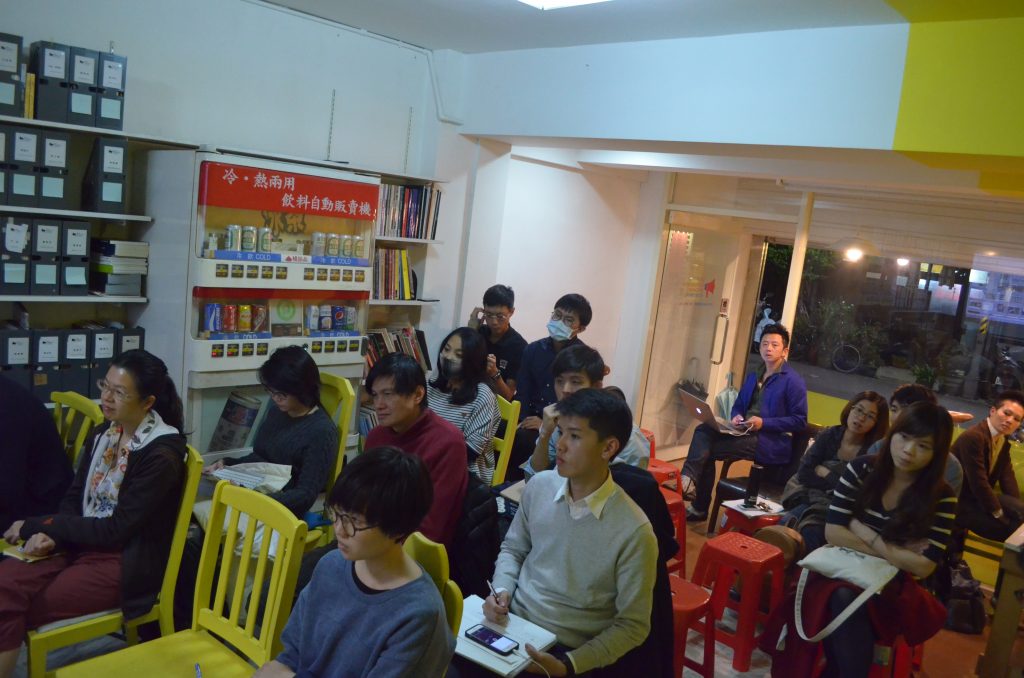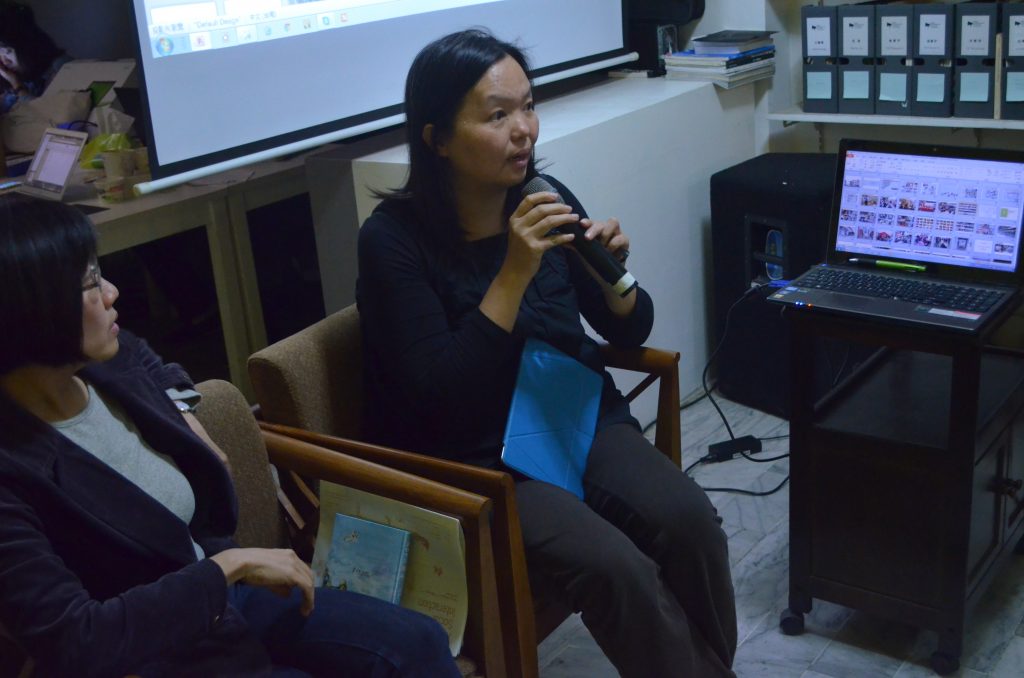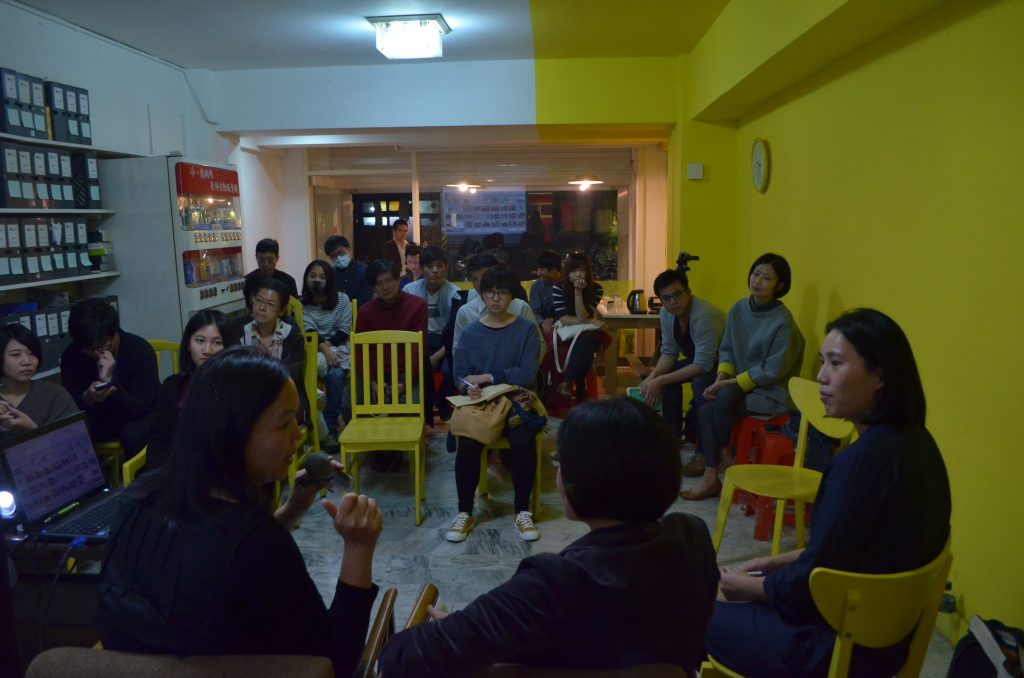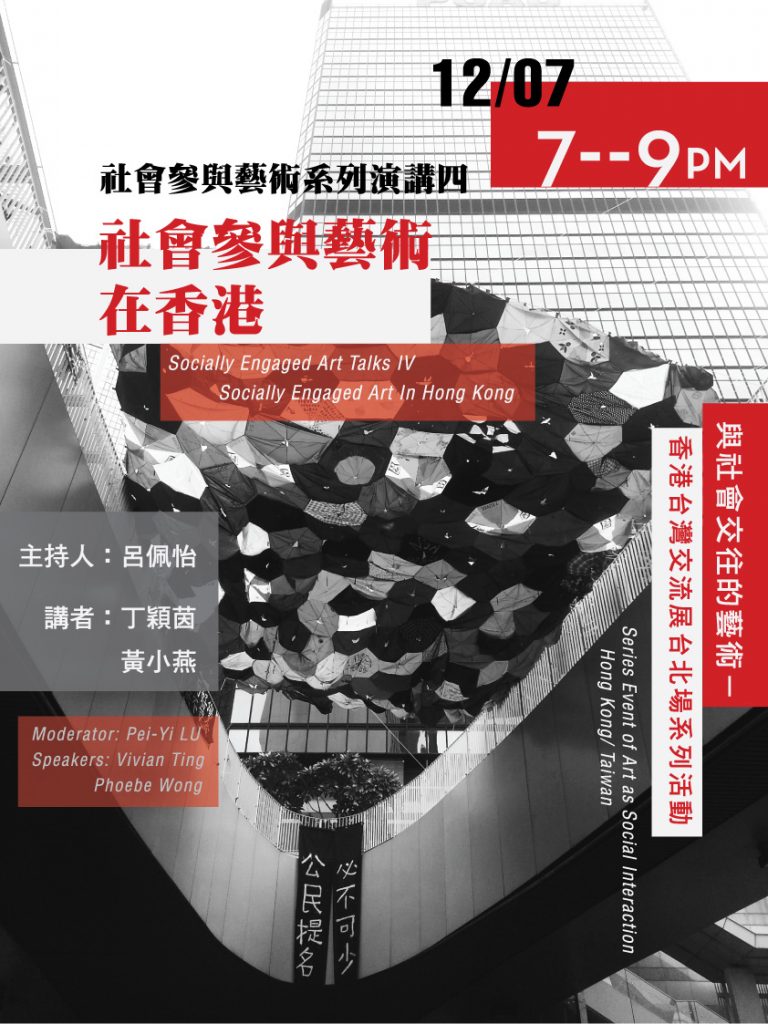 2014.12.07 SUN 7-9PM
2014.12.07 SUN 7-9PM
社會參與藝術系列演講四「社會參與藝術在香港」|與社會交往的藝術-香港台灣交流展台北場系列活動
Socially Engaged Art Talks IV “Socially Engaged Art In Hong Kong”
Art as Social Interaction: Hong Kong Taiwan Exchange – in Taipei
主持人:呂佩怡 | 講者:丁穎茵與黃小燕
Moderator: Pei-Yi LU | Speakers:TING Wing Yan Vivian, Phoebe Wong
與社會交往的藝術-香港台灣交流展
http://artassocialinterac.wix.com/hktw
For English please scroll down.
社會參與藝術系列演講
社會參與藝術系列強調人的主體性與能動性,認為人類的作為一方面帶來進步的生活,但另一方面也造成環境社會的浩劫,這些惡果必須由人來解決。社會參與藝術 (socially-engaged art, participatory art或 social practice)以藝術為施力點,透過人與人之間的合作、參與、聯結、關係建立,讓議題被感知,興起一股「讓我們一起做些甚麼」的想法。此系列將透過幾種不同形式來檢視藝術與社會的關係:【學者專題演講】提供不同地域在社會參與藝術經驗與困境,包括日本、中國、法國等。【藝術家對談】讓藝術家分享其跨地域的社會參與創作經驗。【圓桌論壇】以及【新書發表】等。
與社會交往的藝術-香港台灣交流展台北場系列活動
藝術何以改變世界?它如何介入日常生活?又如何連繫那些對藝術毫無興趣的社群?面對香港層出不窮的社會政治狀況, 例如言論自由日漸緊縮, 貧富懸殊, 公共空間萎縮等, 藝術可以扮演甚麼角色?丁穎茵與黃小燕將在此座談討論社會參與式藝術在香港的狀況與其困境。
座談論點/丁穎茵
九七回歸以降,香港似在國族與本土、城市發展與文化保育之間進退失據,難以對應不同的語境找到自己的位置,思考自己的何去何從。不少藝術家轉向以社會參與(social engagement)作為創作實踐,發掘日常生活微不足道卻又彌足珍貴的人與事,以藝術方式累積改轉社會的能量。然而,西九龍文化區的發展又使得商業機構、社福團體以至公眾也都忽然藝術起來,好像什麼事沒有藝術的點綴總差了一點半點。藝術品牌化的風潮之下,藝術似乎變成了虛飾、例行工事、又或美其名為「社會責任」,究竟社會參與式藝術又如何思考其方向﹖是次座談會從香港的文化生態入手,思考藝術如何介入社會及其意義所在。
座談論點/黃小燕
從介紹民間博物館計畫的項目,兼談藝術x社會在香港的發展脈絡。
1. 藝術系統這些年來的「內部」變化
1.1 藝術體制批判 ──藝術館體制及其展示
1.2 西九龍文化區的爭議
2. 社會運動論述的轉向
2.1 在香港,一九八○、九○年代的社群/社區藝術實踐,是眾樂樂,分享藝術、創作樂趣,以至用藝術治療。社群藝術概念的「擴充」,大約是2000年以後的事。隨著「關係美學」、「對話性創作」等理論的成熟和普及,主體性、公共性和對話性成了藝術用作群社連結、互動的重要概念
2.2 政府的公共/公眾藝術與社區/社群藝術;香港藝術發展局推動的社區藝術;活化廳現象
3 藝術角色的弔詭處境──近年空間抗爭,我們見到:藝術作為城市仕紳化幫兇引發空間議題,而抗爭中卻又促成藝術的生產
呂佩怡/策劃主持
策展人,研究者,藝評人。倫敦大學人文與文化研究博士,研究興趣為off-site art(美術館外的藝術實踐),美術館議題,以及策展研究:透過展覽研究與書寫嘗試建構理論與相關歷史,同時也通過策展實踐去檢視概念,推動理論與實踐並重的當代策展,近期將出版《台灣當代藝術策展二十年:一個實驗性的書寫》。擔任2014年深圳雕塑雙年展「我們未曾參與」副策展人。曾授課於國立台北藝術大學博物館研究所、美術學院、香港中文大學文化管理碩士課程以及台北教育大學藝術與設計系。
丁穎茵
丁穎茵現為獨立研究員,有志於探討觀眾群對藝術的想像及其美學經驗與文化消費的關係。畢業於香港中文大學歷史系,她赴英修讀博物館學,曾於布里斯托巿立博物館、巴斯東亞藝術博物館等地工作,負責整理館藏中國器物的檔案 。現時她於香港浸會大學等教授博物館學及物質文化研究科目,並策劃當代藝術展覽。
黃小燕
黃小燕 (Pheobe WONG),讀設計及文化人類學,搞香港設計、藝術和視覺文化研究。先後成立的民間組織有:「唔知做乜嘅設計聯想會」、「民間博物館計劃」和The AiR。2002年-2011年間,任職亞洲藝術文獻庫(Asia Art Archive)研究部。現為自由撰稿人,文化苦力上身,在思考與勞動的辯證之間,詰問可以為文化做什麼。
文/張舒涵
「社會參與藝術在香港」由黃小燕、丁穎茵分別就現實情況與計畫案例論之。首先,社會參與藝術(socially-engaged art) 的發展在香港受政治、政策、商業等等限制。對香港而言,既沒有民間博物館也沒有廣場、甚至沒有農業、工業。回溯九O年,農工業逐漸退出改以著重商業炒作的經濟景況,增加旅遊外匯收入變得格外重要,「藝術」即被點名為政策手段之一,如同西九文化園區成立初衷。而意味購物中心(shopping mall)的廣場結合展場加以放置的動作,稱之公共藝術諸如此類。藝術非藝術,而是一種「行銷」。此靠攏的關係恰似理所當然,卻又十分弔詭。在於,民眾無法意識到身為「觀眾」這層角色,當他們站在作品之前之中時。面對作品,不是沒有觀眾而是作品本身喪失與外界對話的功能,導致藝術在生活中,藝術卻不存在生活中。
黃小燕與其團隊於2002年共同成立民間博物館計畫(Community Museum Project),將博物館概念帶至圍牆外,正所謂「沒有博物館,只有博物館計畫」。針對香港都市更新、傳統產業、工藝技術,衍生包括:整整一條利東街(四部曲)、小作業大智慧:深水埗工匠+旗津社區計畫,各自維繫著屬人、屬地的獨有生態模式。傾向人類學的、社會調查式的執行,以社區為中心向外擴延與藝術達到連結為操作導向;相較前述將作品放置社區中,試以介入而發生關係,不禁要問:社區真的需要藝術嗎?透過策展,社會資源策畫,進行跨域的資源整合,期望構築起合作平台。2009年成立的活化廳便以此為目5標運行。
不論是西九文化區、M+視覺文化博物館,乃至巴賽爾藝術展,過度重視利益讓人詬病。檯面所見多數抹去甚至忽略香港在地文化,如:公共文化、公共政策、公共分配等等,由好看的、漂亮的、噱頭性十足的予以替代,儼然視藝術為「工具」、為包裝權力的糖衣。之於大眾,藝術是不存在還是看不見?
文/吳冠庭
黃小燕分享自身參與的案例,案例透過博物館方法和角色身分執行計畫,蒐集(文化拾遺)、研究、策展(社會資源策畫)、呈現(呈視社區)、展示、改變,整個流程具有嚴謹的架構,回應到「街道就是博物館」的理念,重要的是「沒有博物館而只有博物館的計畫」,空間在社區中尋找。
黃小燕主要介紹三個案例:
1.示威尤物(2002-2004)
示威是一種都市文化,團隊透過蒐集街頭示威的物件,展覽展出示威道具,一部分代表著言論自由,一部分也反映了民間在有限資源和渠道下的創意。
2.整整一條利東街(2005)
因應政府政策規劃重建,而居民被迫搬遷,整條利東街被剷平。黃小燕的團隊在搬遷之前開始調查研究,利用攝影手法和電腦技術,把一條街的建築面貌和店鋪、住宅景觀呈現出來。之後將利東街店鋪搬遷到灣仔的哪些地方,繪製成了圖表。
3.深水埗工匠圖譜(2007)
團隊從調查深水埗的工匠,歸納出即將消失的行業,並且使之再生。將一個日落行業,經由多方連結,成為「社區資源網絡」。在連結過程中,價值不停的被附加在其中,創造出新的火花。
丁穎茵的觀點從西九文化園區貼切入,看似是為藝術圈注入一股活水,實質上只是撥弄一灘死水,主要還是觀光旅遊導向。文化園區中的M+視覺文化博物館,獲得政府高度資源挹注,讓香港藝術圈的資源不均的現象,更加明顯。商業機構用藝術包裝自己,吸引了大量的人潮,如在黃色小鴨刮起的旋風。丁穎茵將展覽分為四個方向:經濟價值、文化價值、娛樂性、啟發性,香港展覽大多偏向於經濟價值以及娛樂性。K-11更是商業創作出來的弔詭產物,一間百貨公司將自己定位在「購物美術館」,試圖用藝術來美化其商業性。商業與政治夾擊之下,藝術的生存空間又被壓縮。而香港本身的藝術團體,以藝術之名進入社會之中,但丁穎茵提到:「藝術有沒有跟社區對話?社群想要接納藝術嗎?」這是現今藝術家要去思考的議題。
Socially Engaged Art Talks
The series of Socially Engaged Art Talks emphasizes on the subjective and initiative of human being. It suggests that as human being making progress in daily life it also causes inevitably crisis to endanger the environment and our society. These consequences must be resolved by the people. The practice of socially engaged art, participatory art or social practice takes art as a starting point. Through collaboration, participation, connection, relationship building, social issues can be perceived and the idea of “let’s do something together” is emerged.
This series will examine the relationship between art and society through several different forms: Scholars provides lectures and the issues relating to socially engaged art practice and dilemma in different regions, such as Japan, China, France and so on; artists conduct conversation sharing their cross-regional experiences in socially engaged art. Also, a roundtable discussion and a book launch will be held.
Socially Engaged Art Talks IV “Socially Engaged Art In Hong Kong”
Art as Social Interaction: Hong Kong Taiwan Exchange – in Taipei
How does art change the world? How does it intervene daily lives? How does it connect with communities uninterested in art? Under recurring social and political circumstances, such as restricting freedom of expression, widening wealth gap and shrinking public spaces, what roles can art play in the process? In this panel, Vivian Ting and Phoebe Wong will discuss social engaged art in Hong Kong and its challenges.
Perspective: TING Wing Yan Vivian
The post-colonial Hong Kong finds itself in a dilemma oscillating between the discourses of the Nation and the locals, and that of city development and cultural preservation. Socially engaged art projects became an important means that enables local artists to unravel the wonders buried by daily life experiences and promote positive changes to the society. Curiously, the development of the West Kowloon Cultural District encourages corporations and social welfare oragnisations and even the public to consider arts as an economic drive. All of the sudden, art seems to be a pretentious routine or euphemistically “social responsibility”. This talk aims to contextualise socially engaged art practices in relation to the cultural ecology of Hong Kong and reflect on how art engages into the society and why it is meaningful to involve the community.
Perspective: Phoebe WONG
Programs in Community Museum Project as well as development contexts in art and society in Hong Kong
1. (Internal) Changes in art systems over the years
1.1 institutional critique ── Art institutional critique: institution and its display
1.2 Controversies around West Kowloon Cultural District
2. Transformations in social movement discourses.
2.1 Community art practices in 1980s and 1990s in Hong Kong focused on sharing art, joy in creation, and even art therapy. They were “expanded” after 2000. As theories, such as relational aesthetics and conversational art, become mature and universal, subjectivity, publicness and conversation evolve as important art concepts for community interaction and connection.
2.2 Official public arts and community arts, community arts supported by Hong Kong Arts Development Council, Woofer Ten incident
3. Art and its paradoxical position: During protests and demonstrations for space in recent years, we notice that art has become an accomplice in gentrification, but protests also facilitate art production
Dr. Lu Pei-Yi/ Moderator
A researcher, art critic and curator. She was awarded PhD in humanity and Cultural Studies from University of London. Her research interests are off-site art, museum studies and curating in theory and practice. Recently, a research-based book Contemporary Art Curating in Taiwan Two Decades is going to be published. She is an associate curator of 8th Shenzhen Sculpture Biennale “We Have Not Participated” (2014). She had been as an assistant professor of Museum Studies MA, National Taipei University of the Arts and served as a visiting assistant professor in Cultural Management MA, Chinese University of Hong Kong. She is teaching part-time in Fine art school, National Taipei University of the Arts and National Taipei University of Education.
TING Wing Yan Vivian
Vivian is a freelance researcher who is interested in examining on how people engage in art activities in a wider context of cultural consumption. Trained as historian at the Chinese University of Hong Kong, she did Museum Studies at the University of Leicester and gained extensive curatorial experience the Museum of East Asian Art in Bath and the Bristol City Museum and Art Gallery where she had been involved in conducting research on Chinese collection. She has been teaching Museum Studies and Material Culture Studies in universities and working on contemporary curatorial projects.
Phoebe WONG
Phoebe studies design and cultural anthropology, and conducts design, art and visual cultural studies in Hong Kong. She has founded several private organizations, such as Designs You Don’t Know What To Do With Association, Community Museum Project and The AiR. She worked in research department in Asia Art Archive from 2002 to 2011, and is currently a freelance writer. As a cultural worker, she contemplates what she can do for culture between reflection and labor.
台北當代藝術中心由文化部及RC Art Collection贊助營運。
TCAC is sponsored by the Ministry of Culture and RC Art Collection.
「與社會交往的藝術-香港台灣交流展」由國藝會視覺藝術
“Art As Social Interaction Hong Kong/ Taiwan Exchange” is sponsored by NCAF.

